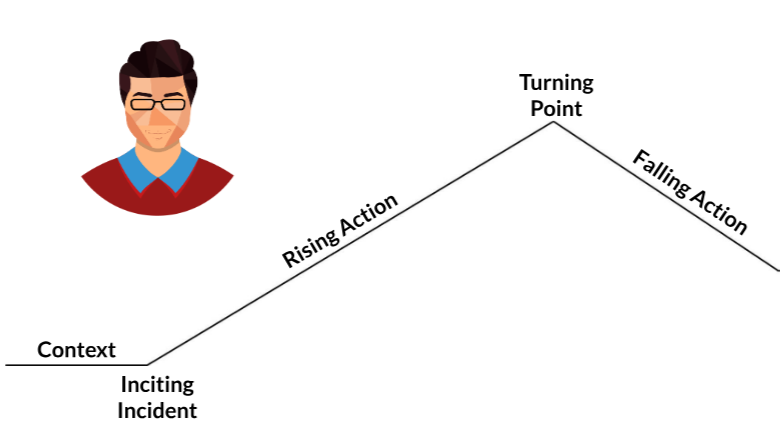How to Add Stories to Your Next Presentation

Storytelling is one of the most compelling ways to elevate your presentation and engage your audience, regardless of who they are. Stories can help you…
- simplify complex information, making it easier for your audience to understand.
- create a connection between storyteller and audience.
- engage your audience emotionally to buy-into you and your ideas.
… and so much more!
While there are many reasons to add stories to your presentation, it’s important to avoid letting them get rambly, long, dry, or convoluted.
What is a story?
When we work with our clients to help them craft stories to incorporate into their presentations, we often start by discussing exactly what a story is. A story has at least one character that goes on a literal or metaphorical journey. This journey can be described with the six basic building blocks of story structure outlined below. The most important elements of the story—the Inciting Incident and the Turning Point—are very specific moments in time where the character experiences, learns, or notices something. When crafting a story, ensuring clarity and specificity with respect to these two moments helps the story become experiential rather than simply being an overview, description, or summary.
Here is a high-level diagram of a story. Notice that the Inciting Incident and Turning Point are moments that give shape to the story. The other building blocks of the story structure are helpful in giving the story depth and substance.
A key point relevant to stories and presentations is that stories must follow story structure while a presentation doesn’t have to. In fact, presentations often have a very different narrative structure. That being said, because human beings respond so well to stories, it can be helpful to embed short stories that follow this structure into a broader presentation narrative.
To help our clients embed stories into their presentations, we typically encourage them to take an intentional look at their story ideas through the lens of the building blocks of the story. If you’d like to do the same, use this tool to get started.
Once you have your initial ideas sketched out, consider the following:
ENHANCE
- Stories are easier to follow and more memorable when the listener can “see” them with their mind’s eye. What details can you add to make the story easier for the listener to visualize?
- Stories are more likely to build a connection between you and the listener when you’re authentic and vulnerable. How are you, as the storyteller, showing up in the story? Go beyond describing what’s happening “outside of you” and include elements of your internal dialogue, your connection to the situation or character, or why it matters to you.
- Stories are more likely to be engaging for the listener if they include elements of suspense. How are you building suspense or mystery? Spend more time describing the conflict or challenge than on the resolution that is ultimately discovered.
- Stories are more likely to be memorable when they create emotional experiences for the listener. How are you creating opportunities for your audience to feel something during the story? Describe physiological experiences in lieu of simply naming emotions, or use metaphor or internal dialogue to add substance.
EDIT:
- Stories are more impactful when they focus on a single message or idea. What is the main takeaway you want your listener to understand? Once you clarify that, use it to determine the details you can remove from the story without losing what’s important.
- Story characters go on a journey or undergo some kind of change, whether big or small. How is the main character different, or what is new for the main character at the end of the story?
What do you see as the best stories to include in presentations or talks?
- Stories are more impactful when they focus on a single message or idea. What is the main takeaway you want your listener to understand? Once you clarify that, use it to determine the details you can remove from the story without losing what’s important.
- Story characters go on a journey or undergo some kind of change, whether big or small. How is the main character different, or what is new for the main character at the end of the story?
What do you see as the best stories to include in presentations or talks?
Recent Posts





